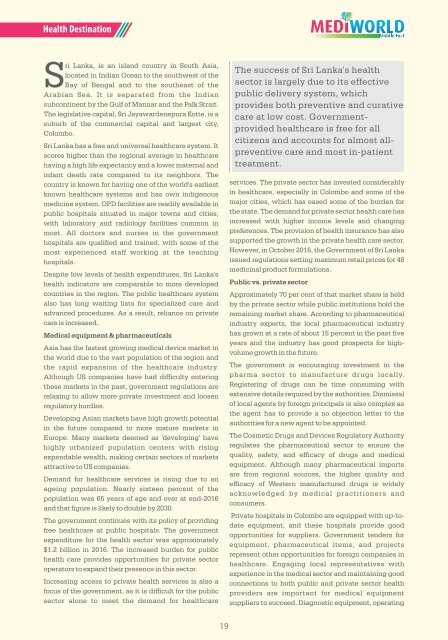You also want an ePaper? Increase the reach of your titles
YUMPU automatically turns print PDFs into web optimized ePapers that Google loves.
Health Destination<br />
ri Lanka, is an island country in South Asia,<br />
Slocated in Indian Ocean to the southwest of the<br />
Bay of Bengal and to the southeast of the<br />
Arabian Sea. It is separated from the Indian<br />
subcontinent by the Gulf of Mannar and the Palk Strait.<br />
The legislative capital, Sri Jayawardenepura Kotte, is a<br />
suburb of the commercial capital and largest city,<br />
Colombo.<br />
Sri Lanka has a free and universal healthcare system. It<br />
scores higher than the regional average in healthcare<br />
having a high life expectancy and a lower maternal and<br />
infant death rate compared to its neighbors. The<br />
country is known for having one of the world's earliest<br />
known healthcare systems and has own indigenous<br />
medicine system. OPD facilities are readily available in<br />
public hospitals situated in major towns and cities,<br />
with laboratory and radiology facilities common in<br />
most. All doctors and nurses in the government<br />
hospitals are qualified and trained, with some of the<br />
most experienced staff working at the teaching<br />
hospitals.<br />
Despite low levels of health expenditures, Sri Lanka's<br />
health indicators are comparable to more developed<br />
countries in the region. The public healthcare system<br />
also has long waiting lists for specialized care and<br />
advanced procedures. As a result, reliance on private<br />
care is increased.<br />
Medical equipment & pharmaceuticals<br />
Asia has the fastest growing medical device market in<br />
the world due to the vast population of the region and<br />
the rapid expansion of the healthcare industry.<br />
Although US companies have had difficulty entering<br />
these markets in the past, government regulations are<br />
relaxing to allow more private investment and loosen<br />
regulatory hurdles.<br />
Developing Asian markets have high growth potential<br />
in the future compared to more mature markets in<br />
Europe. Many markets deemed as 'developing' have<br />
highly urbanized population centers with rising<br />
expendable wealth, making certain sectors of markets<br />
attractive to US companies.<br />
Demand for healthcare services is rising due to an<br />
ageing population. Nearly sixteen percent of the<br />
population was 65 years of age and over at end-2016<br />
and that figure is likely to double by 2030.<br />
The government continues with its policy of providing<br />
free healthcare at public hospitals. The government<br />
expenditure for the health sector was approximately<br />
$1.2 billion in 2016. The increased burden for public<br />
health care provides opportunities for private sector<br />
operators to expand their presence in this sector.<br />
Increasing access to private health services is also a<br />
focus of the government, as it is difficult for the public<br />
sector alone to meet the demand for healthcare<br />
The success of Sri Lanka's health<br />
sector is largely due to its effective<br />
public delivery system, which<br />
provides both preventive and curative<br />
care at low cost. Governmentprovided<br />
healthcare is free for all<br />
citizens and accounts for almost allpreventive<br />
care and most in-patient<br />
treatment.<br />
services. The private sector has invested considerably<br />
in healthcare, especially in Colombo and some of the<br />
major cities, which has eased some of the burden for<br />
the state. The demand for private sector health care has<br />
increased with higher income levels and changing<br />
preferences. The provision of health insurance has also<br />
supported the growth in the private health care sector.<br />
However, in October 2016, the Government of Sri Lanka<br />
issued regulations setting maximum retail prices for 48<br />
medicinal product formulations.<br />
Public vs. private sector<br />
Approximately 70 per cent of that market share is held<br />
by the private sector while public institutions hold the<br />
remaining market share. According to pharmaceutical<br />
industry experts, the local pharmaceutical industry<br />
has grown at a rate of about 15 percent in the past five<br />
years and the industry has good prospects for highvolume<br />
growth in the future.<br />
The government is encouraging investment in the<br />
pharma sector to manufacture drugs locally.<br />
Registering of drugs can be time consuming with<br />
extensive details required by the authorities. Dismissal<br />
of local agents by foreign principals is also complex as<br />
the agent has to provide a no objection letter to the<br />
authorities for a new agent to be appointed.<br />
The Cosmetic Drugs and Devices Regulatory Authority<br />
regulates the pharmaceutical sector to ensure the<br />
quality, safety, and efficacy of drugs and medical<br />
equipment. Although many pharmaceutical imports<br />
are from regional sources, the higher quality and<br />
efficacy of Western manufactured drugs is widely<br />
acknowledged by medical practitioners and<br />
consumers.<br />
Private hospitals in Colombo are equipped with up-todate<br />
equipment, and these hospitals provide good<br />
opportunities for suppliers. Government tenders for<br />
equipment, pharmaceutical items, and projects<br />
represent other opportunities for foreign companies in<br />
healthcare. Engaging local representatives with<br />
experience in the medical sector and maintaining good<br />
connections to both public and private sector health<br />
providers are important for medical equipment<br />
suppliers to succeed. Diagnostic equipment, operating<br />
19

















